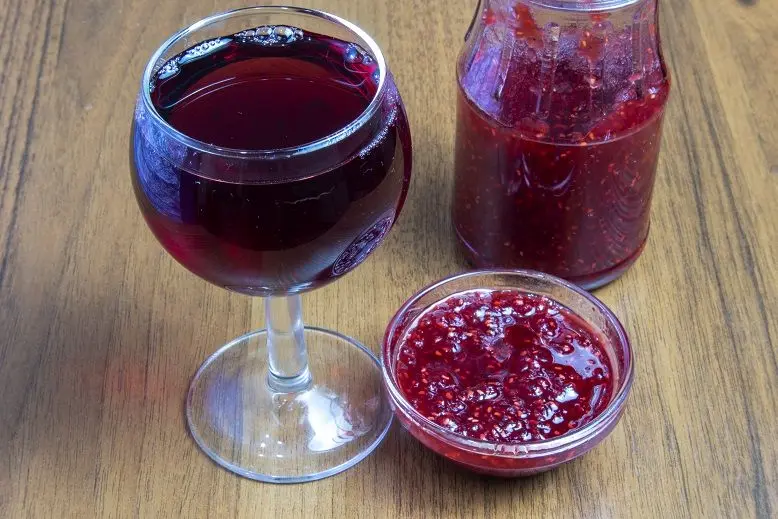Every year, thrifty housewives have at least a few cans of last year’s jam. I no longer want to eat it, since a new one has been prepared, and it’s a pity to throw away a natural product, the preparation of which has spent effort and money. I suggest the next way out – to make homemade wine from jam. We will consider the recipe and technology further.
In advance, I advise you to find a three-liter jar, a nylon lid, gauze and a medical rubber glove (you can install a water seal instead). In this recipe, we will do without yeast, since it is difficult to get wine, and ordinary pressed or dry ones are not used in winemaking, turning wine into ordinary mash. The role of yeast will be performed by raisins, on the surface of which the necessary fungi live.
For making homemade wine, jam from apples, currants, raspberries, strawberries, plums, cherries and other fruit crops is suitable. But I do not advise mixing different types of jam in one drink: the unique taste of each berry is lost in the mixture. It is better to make several separate portions.
Ingredients:
- jam – 1 liter;
- water – 1 liter;
- unwashed raisins – 100 grams;
- sugar – 10-100 grams per liter of water (optional).
The amount of water depends on the sugar content in the jam (natural in raw materials and added during the cooking process). It is necessary to strive so that the sugar content in the wort does not exceed 20%. If necessary, dilute with more water. If initially the jam is not sweet, you can add more sugar.
Old Jam Wine Recipe
1. Wash a three-liter jar with soda, rinse several times with warm water, then sterilize by pouring a little boiling water. This will kill pathogens that can taint the wine.
2. Transfer the jam to a jar, add water and sugar (if necessary), add unwashed raisins. Mix until a homogeneous mass is obtained. Instead of raisins, you can use any unwashed fresh berries that need to be crushed beforehand.
The authors of some recipes advise adding a handful of rice to the raisins. But rice does not promote fermentation, it is a useless undertaking.
3. Cover the jar with gauze to protect against flies, transfer to a warm (18-25°C) dark place or cover with a thick cloth. Leave for 5 days, stir once a day with a clean hand or wooden fixture. After 8-20 hours, signs of fermentation should appear: hiss, foam and a slight smell of sour. This means that everything is going well.
4. Remove the pulp (floating pulp) from the surface, strain the contents of the jar through gauze folded in several layers. Pour the filtered wort into a clean jar, previously washed with soda and boiling water. The container can be filled up to a maximum of 75% of the volume to leave room for foam and carbon dioxide that will appear during fermentation.
5. In one of the fingers of a medical glove, make a hole with a needle, and then put the glove itself on the neck of the jar. To keep the structure better and not fall off during fermentation, tie the neck with a rope over the glove.

An alternative way is to install a water seal. There is no difference between these two options. If you make homemade wines all the time, it is better to build a water seal, it is universal, in other cases a glove will do (each time a new one).
6. Put the jar for 30-60 days in a dark warm place. Fermentation will end when the inflated glove is completely deflated or the water seal will not bubble for several days. The wine itself should become lighter, and sediment will appear at the bottom.
Attention! If fermentation does not stop after 50 days from the date of installation of the water seal, the jam wine must be drained without touching the sediment at the bottom. Then again put under the water seal ferment. If this is not done, the drink may be bitter.
7. Drain the fermented young wine from the sediment. Taste, if desired, add sugar for sweetness or vodka (alcohol) to increase the strength (2-15% of the volume). Fortified wine made from jam is better stored, but not as aromatic and has a harsher taste.
Pour the drink into clean containers, it is advisable to fill up to the neck so that there is no contact with oxygen. Close tightly, transfer to the basement or refrigerator. Withstand at least 2-3 months (preferably 5-6). The optimum temperature is 6-16°C.
First, once every 20-25 days, then less often when a sediment appears in a layer of 2-5 cm, filter the wine by pouring it into another container. Long stay on the sediment can lead to bitterness. The finished drink (the precipitate no longer appears) can be bottled and hermetically sealed with corks.

The strength of the prepared wine is 10-13%. Shelf life when stored in a cellar or refrigerator – up to 3 years.









